Obesity – An Epidemic And The Scientific Approach to Combat It
This content has been Medically reviewed by Dr. B Padmavathi, MBBS, DGO – Preventive & Social Medicine Obstetrician and Gynecologist
Introduction
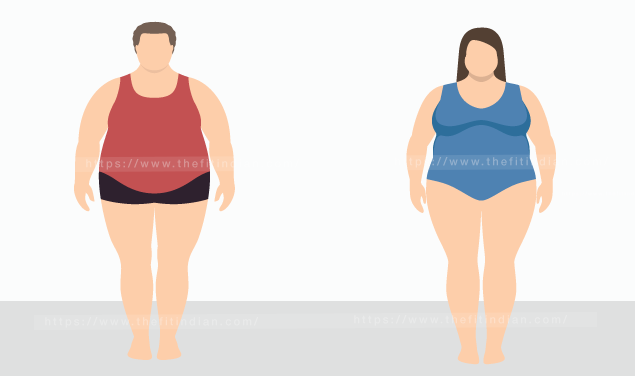 What is Obesity?
What is Obesity?
Obesity is defined as a condition where abnormal or excessive fat is accumulated in the body. It is a worldwide epidemic that contributes to numerous chronic diseases and early mortality. According to NIH (National Institute of Health) and WHO, obesity is defined as a BMI (Body Mass Index) of 30 and above.
Obesity is an epidemic that has received both national and international attention because of its detrimental impact on health, the enormous economic burden it imposes, and its increasing prevalence. Obesity occurs when there is a gradual but persistent weight gain over a considerable period of time.
Epidemiology of Obesity
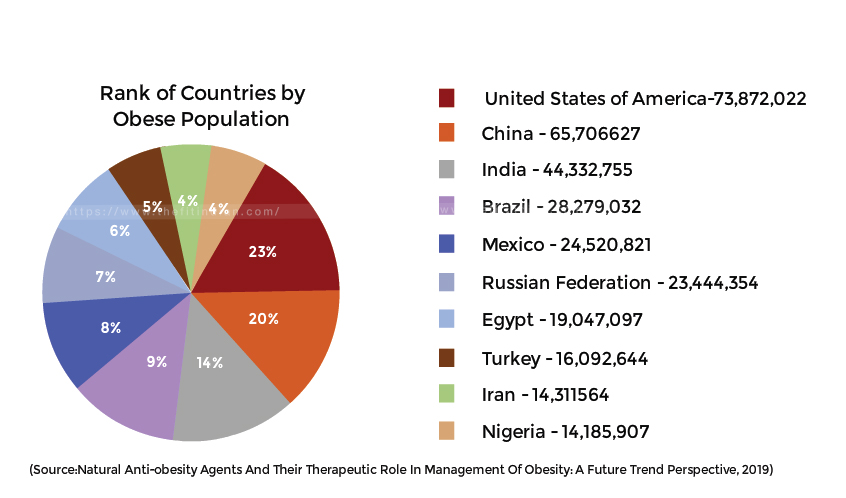 Among the 7.5 billion population of the world, 0.774 billion were found to be obese; out of which, 1.9 million were overweight and 650 million obese. 41 million children under 5 years of age and 340 million children above 5 years of age were found to be overweight or obese in the year 2016. The prevalence of obesity among adults has been increasing over the last 30 years in virtually every country in the world.
Among the 7.5 billion population of the world, 0.774 billion were found to be obese; out of which, 1.9 million were overweight and 650 million obese. 41 million children under 5 years of age and 340 million children above 5 years of age were found to be overweight or obese in the year 2016. The prevalence of obesity among adults has been increasing over the last 30 years in virtually every country in the world.
Between 1980 and 2013, it has increased from approximately 29 to 38 % in men and from 30 to 39.0 % in women. Obesity is a complex, multifactorial, and largely preventable disease. If secular trends continue, by 2030 an estimated 38% of the world’s adult population will be overweight and another 20% will be obese.
WHO Classification of Obesity and Overweight
| Classification | BMI (kg/m2) | Risk of comorbidities (a medical condition that co-occurs with anothers) |
|---|---|---|
| Underweight | >8.50 | Low (but the risk of other clinical problems increased) |
| Normal range | 18.50-24.99 | Average |
| Overweight | ||
| Pre- obese Obese Class I Obese Class II Obese Class III |
>25.00 25.00-29.99 30.00-39.99 >40.00 |
Increased Moderate Severe Very severe |
In clinical practice, simpler methods are used, such as the weight-height tables, the body mass index (BMI) assessment, and skinfold measurements. The severity of obesity is estimated from the total amount of fat and fat distribution in the human body. Accurate measurement of the amount of fat requires methods and equipment that exist only in medical and research laboratories. WHO BMI cut-off points should be retained as international classifications.
Screening and Assessment of Obesity
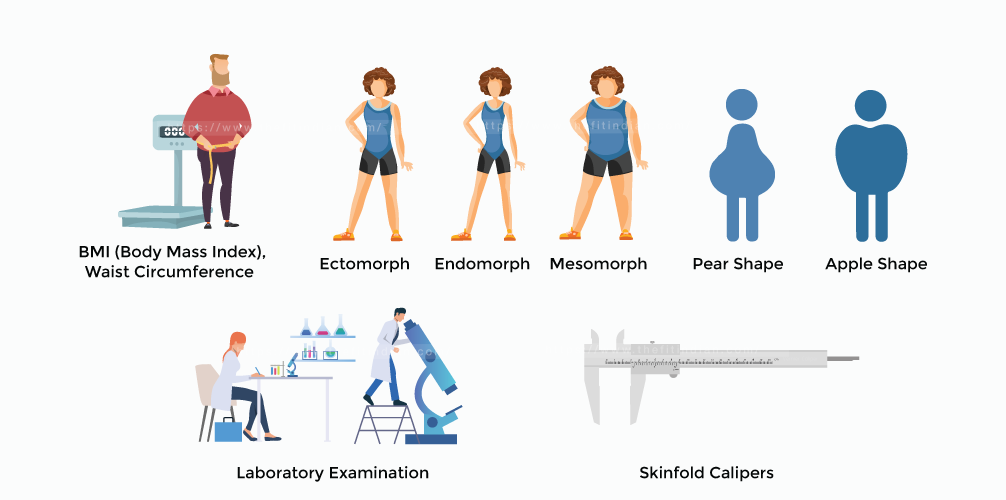 BMI (Body Mass Index)
BMI (Body Mass Index)
BMI is used as a preliminary confirmation method for obesity or overweight. It is the most appropriate simple indicator by which weight-for height can be related to health outcomes. WHO (1995) therefore proposed the use of BMI to monitor both undernutrition and overweight.
Nevertheless, international convention, as represented by two major WHO Technical Consultations (WHO 1995, 2000), endorsed the use of a common BMI scheme for adults irrespective of gender or age. BMI alone cannot be used to predict health status as it does have some setbacks and limitations. So various other methods are in trend nowadays.
Waist Circumference
Waist circumference measurement is one of the most reliable screening methods. It correlates with the amount of intra-abdominal or visceral fat. To measure your waist circumference, stand and place a measuring tape around your waist, just above your hip bones. Measure your waist circumference just after you breathe out.
The measurement of waist circumference is often found to be more valuable than the BMI itself. An excess of abdominal fat has been associated with a range of metabolic abnormalities and diseases. As per the general survey, a man’s waist should be no more than 40 inches while if you are a woman, it should not be more than 35 inches (except in the case of pregnant women).
Waist to Hip Ratio
Waist to hip ratio is also an important criterion that has to be considered in obesity measurement techniques. The hip measurement indicates the degree of fat accumulation around the hips and this deposition may help in some way to limit the health impact of abdominal fat accumulation.
Men with a waist-to-hip ratio higher than 0.9 have too much abdominal fat accumulation. Women with a number higher than 0.85 are carrying too much weight. The waist-to-hip guidelines differ by gender because men tend to carry extra weight in their bellies, while women show it more in the hips and buttocks.
Body Shapes and Body Patterns
Your body shape can say quite a lot about your health but it is important to remember that it is just one factor. People of all shapes and sizes can be healthy. But could become unhealthy if they do not take care of themselves appropriately.
Ectomorph
This body type may look skinny and find it hard to put on weight in spite of having more body fat. The body often processes food quickly, which makes it harder to build muscle. They have narrower frames, thinner bones, and smaller joints, and maybe flatter in the chest and butt.
Endomorph
This body type usually has more body fat and muscle, smaller shoulders, shorter limbs, and a larger bone structure. These usually have a tendency of gaining weight easily, especially in lower belly and hips.
Mesomorph
This type of body usually has an athletic, strong build with broad shoulders, a narrow waist, and low body fat. Naturally, a strong one can lose and gain weight easily. These body pattern individuals are well-suited for bodybuilding.
Pear Shape
This body pattern is more common among women. People with this shape have extra fat in the hip and thigh area.
Apple Shape
Also named ‘beer belly’, fat is stored around the stomach in this body shape, while the lower body stays thin. It’s more common in men, and it’s worse for one’s health than the pear shape. As belly fat is often a sign that there is more fat deeper inside, around your internal organs or beneath the skin. This kind of fat storage is more likely to accompany health conditions such as heart disease, cancer, type 2 diabetes, and high cholesterol.
Body Fat Measurement Methods
Skinfold Calipers
In skinfold analysis, with the help of special calipers, different parts of the body are pinched and subcutaneous fat is measured. Total body fat can be estimated by measuring the fat under the skin. Though this method is reliable, it does have several drawbacks. For example, this method does not measure visceral fat.
This method delivers inconsistent results as different people pinch differently, making its accuracy vary. In women, the area above the hip bone, thigh and abdomen are measured. In men, the chest area, abdomen, thighs or triceps are measured.
Dual-Energy X-ray Absorptiometry (DEXA)
This method is mostly used for bone density measurement. It helps to analyze the bone mineral density, lean body mass and fat mass in the overall body. It is accurate and helps to measure the detailed body composition. It is expensive and not available everywhere. Radiation exposure is the main disadvantage of this method.
Hydrostatic Weighing
It is also called underwater weighing or hydrodensitometry. It is based on the Archimedes principle of fluid displacement, often named as underwater weighing. The weight of the individual is measured on land first and then submerged underwater and weighed. Two weights (water and land weight) are then entered into equations to generate body fat percentage.
Bioelectrical Impedance (BIA)
In this method, a low-intensity electric current is passed through the body and the resistance is measured. The faster the current travels from one lead to another, the more muscle and less fat the person has. People need to follow various rules to generate the right estimate.
Air-Displacement Plethysmography
The method is also called BOD POD. It works on a similar principle as underwater weighing, except it measures air displacement. Several studies showed that BOD POD’s accuracy is similar to that of underwater weighing. Measurement with the BOD POD takes seconds. It is a safe, fast, accurate and non-invasive method of obtaining body fat measurements. The only downside is that it is expensive and not easily available. It uses the relationship between pressure and volume to derive the body volume of a subject seated inside a fiberglass chamber.
Laboratory Examination
Along with physical examination. There are a number of laboratory tests that help analyze a person’s overall health, risk factors, and current symptoms for obesity. Those blood tests include Serum lipid profile (Total, HDL and LDL cholesterol, Triglycerides) Uric acid, Thyroid-stimulating hormone [TSH] level,
Liver: Liver function (hepatic enzymes), Liver investigation (ultrasound, biopsy) for abnormal liver function. NAFLD (nonalcoholic fatty liver disease) or other liver pathology tests are suggested.
A physician may also recommend certain heart-related tests, such as an electrocardiogram (ECG) to examine the risk of developing cardiac ailments due to obesity. All these tests are just general information that should be done as prescribed by a physician.
Root Causes of Obesity
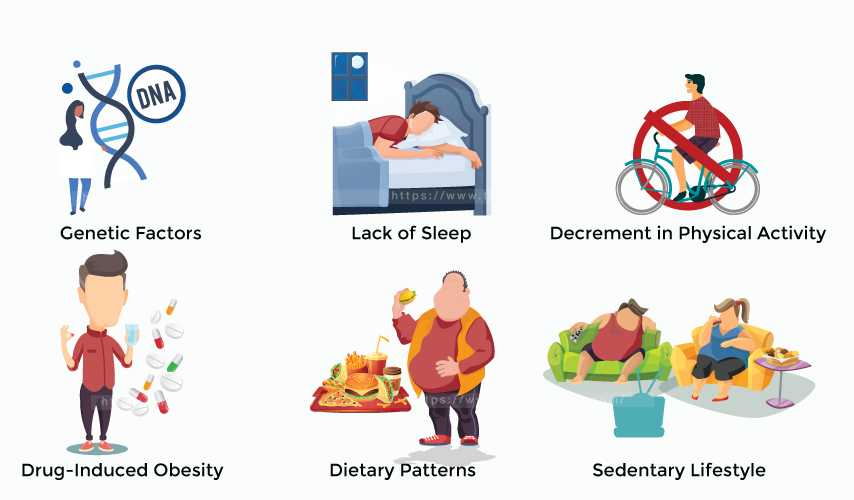 Dietary Patterns
Dietary Patterns
As it is rightly said, a healthy diet is a solution to many of our health-care problems. The increasing westernization, urbanization, and mechanization occurring in most countries around the world is associated with changes in the diet. Numerous conveniently located eating establishments that promote dining away from home, a high variety of foods at mealtime and unreasonably large portion sizes may be factors leading to weight gain. Obesity continues to increase due to overeating, frequency of eating, a diet high in carbohydrates, low in protein and high in saturated fats.
Behavioural, Environmental and Social Factors
Various behavioral and environmental factors such as high energy density diet, increased portion size, low physical activity and adoption of a sedentary lifestyle as well as eating disorders are considered important risk factors for the development of obesity. It has been observed that obesity is more common in people of higher socioeconomic status and among those living in urban communities. Lack of accessibility to healthy food choices and the commercially driven food market environment are also considered as other probable causes of obesity.
Age and Gender
Gender differences are also apparent in the patterns of weight gain and the development of overweight and obesity. These patterns are partially attributable to hormonal differences between men and women before menopause and hormonal changes in women during menopause.
It has been observed that in perimenopausal and postmenopausal periods, many women experience alterations in body weight, total body fat, and body fat distribution. Older people generally have more fat than younger adults do; because relatively more fat accumulates in the abdomen and less fat at the extremities as people age.
Influences of Genetic Factors
Obesity has long been associated with genetic components. Although several genes based on familial cases have been identified, the majority of obese individuals occur randomly in the population.
It is now accepted that obesity is a complex, non-mendelian trait that may result from numerous susceptible loci. The etiology of obesity is multifactorial, involving a complex interaction among genetics, hormones and the environment. Though multiple candidate genes have been implicated in the pathogenesis of obesity, these findings are inconsistent.
Decrement in Physical Activity
Along with dietary changes lifestyle changes that reflect reduced physical activity are among the risk factors. Several studies have shown that insufficient physical activity is one of the important risk factors of obesity. Work-related activity has declined over recent decades in industrialized countries due to modernization, convenient services, and high standard of living. Leisure time dominated by television viewing and other physically inactive pastimes has increased, and this habit ultimately results in weight gain and obesity.
Lack of Sleep
Obesity is a complex condition that can be influenced by a wide range of factors. One of the factors is sleep duration. Sleep deficiency is becoming widespread in both adults and adolescents and is accompanied by certain behaviors that can lead to obesity. Various studies have found that people with shorter sleep duration are more likely to be overweight or obese, hence strategies for the obesity management should incorporate of sleep pattern considerations.
Drug-Induced Obesity
One of the causes of obesity is medication-induced weight gain. Different drug classes such as antipsychotics, antidepressants, antihyperglycemics, antihypertensives and corticosteroids, contain medications that are associated with significant weight gain.
As the use of pharmaceuticals continues to increase, it is pertinent for clinicians to consider the weight-gaining effects of medications prior to prescribing or in the course of treatment.
Binge Eating Disorder (Overeating)
Binge eating disorder (BED) is characterized by eating larger amounts of food than most people should eat in a set time period with a sense of lack of control during these episodes. BED is estimated to occur in 20 to 50 percent of individuals. Related features include eating until uncomfortably full, eating when not physically hungry, eating when alone and feeling depressed or guilty. BED is associated with increased psychopathology including depression and personality disorders.
Leptin Deficiency
Leptin is a protein-hormone containing 167 amino acids secreted from the fat cells (adipocytes) in the body. It regulates food intake. This hormone signals the brain to eat less food, controlling appetite. In some individuals, leptin deficiency or leptin resistance occurs, which ultimately hampers brain signaling which may directly lead to obesity.
More Simple and Less Complex Carbohydrates
Complex carbohydrates – These are sugar molecules of complex long chains. They provide vitamins, minerals, and fiber. Foods such as bread, legumes, rice, pasta, peas, beans, nuts and vegetables are rich in complex carbohydrates.
Simple Carbohydrates: These are derived from highly processed and sugar-added foods and beverages, which usually provide empty calories. This form of carbohydrate consumption may lead to obesity. Most notable among children and young adults.
Complications Caused by Obesity
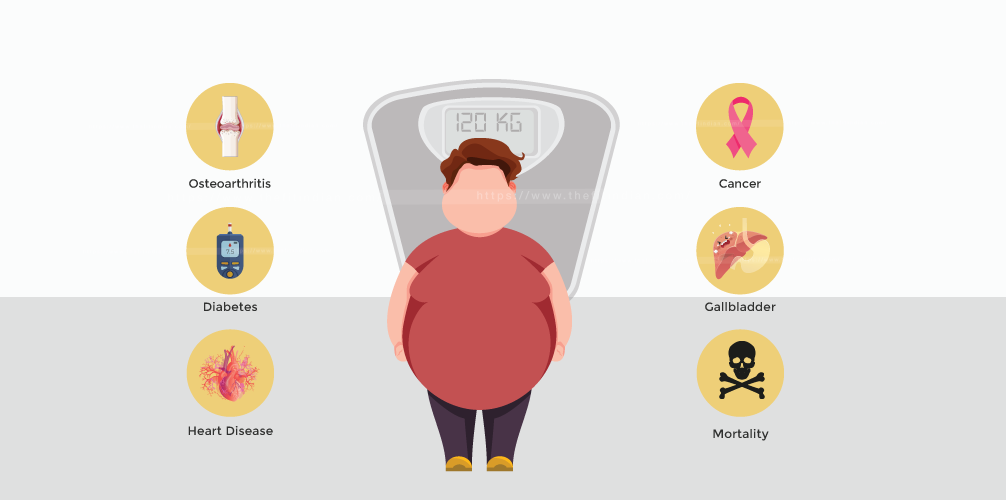 Type II Diabetes
Type II Diabetes
The relationship between excess body-weight gain and type II diabetes is now considered so strong that there is increasing use of the term “diabesity” as a unifying concept. Not only is there a close association between higher BMIs and the risk of developing type II diabetes, but weight gain itself has also been identified as a particularly important risk factor.
More direct evidence from intervention studies shows insulin resistance itself is affected by increases in weight, particularly if the extra energy is stored as visceral fat in the abdomen.
Cardiovascular Disease
Non-optimum levels of blood pressure, cholesterol and glucose are leading causes of cardiovascular disease. There is strong evidence that excess body weight is associated with adverse levels of these risk factors. A lot of clinical trial data document the significant BP-lowering effect of weight loss. There are dense associations among individuals and hypertension with obesity. It was also found that prehypertension was associated with an increased risk for cardiovascular disease, including myocardial infarction (MI) and coronary artery disease (CAD).
Cancer
There have been recent associations between excess weight gain and the development of different forms of cancer. The latest review by the International Agency for Research on Cancer (IARC) lists the risk of different cancers in relation to both body weight and physical activity. These analyses concluded that cancers of the colon, breast (postmenopausal), endometrium and kidney were statistically related to weight gain, each analysis is usually based on a systematic review of a large number of both case-control and prospective studies.
Gallbladder Disease
It has been recognized that excess weight gain is associated with a greater propensity to the development of gallstones and gallbladder disease. This relationship is mostly observed in developed societies. As data on gallbladder disease are not collected systematically in many countries it is not possible to undertake an appropriate international analysis of the risk associated with weight gain.
Osteoarthritis
There is a well-documented association between high BMI and the development of osteoarthritis in both men and women. Osteoarthritis is an abnormality that involves damage and eventually the destruction of the articular cartilage of the joint. The relationship between excess weight and the development of osteoarthritis has been studied showing excess weight as the most important risk factor for osteoarthritis and could be prevented.
Gout
Gout is a metabolic disease of uric acid metabolism, which has a genetic component and involves acute episodes of arthritis leading to chronic arthritis and disability. Although much less common than osteoarthritis, gout has also been linked with excess weight gain in various studies. With other large studies suggesting that excess weight as early as adolescence is predictive of gout.
Mortality of Obesity
Obesity has been associated with higher mortality. The nature of obesity-related health risks is similar in all populations, although the specific level of risk associated with a given level of overweight or obesity may vary with race/ethnicity and also with age, gender, and societal conditions.
Excluded Health Outcomes
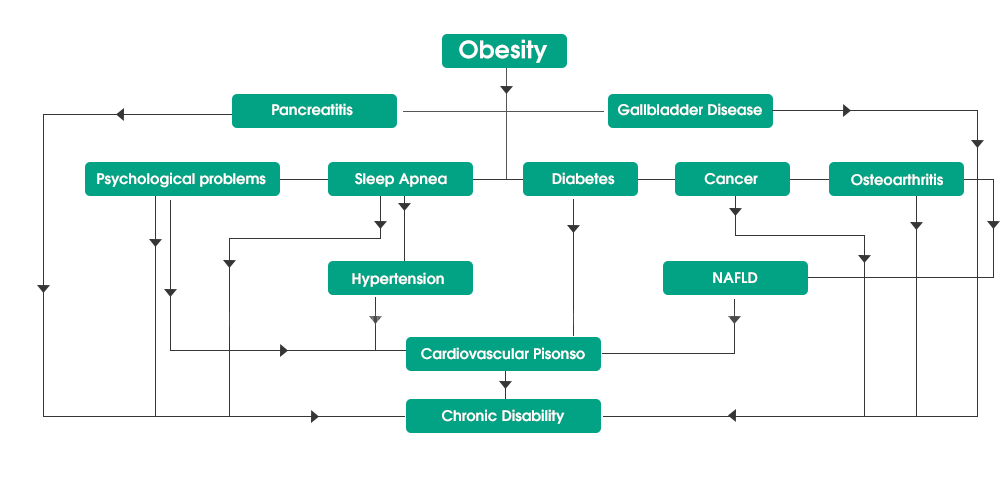
A number of other conditions have been widely quoted as concomitants of body-weight gain in affluent societies. The reasons for excluding these conditions are as follows.
Breathlessness
It has been observed that obesity may cause shortness of breath. Breathlessness on even a small exertion is a very common symptom in the obese.
Sleep Apnea
This is a well-described clinical complication of excess weight, which affects very obese children and adults. It is generally considered to occur in those with more extreme forms of obesity.
Back Pain
There are many causes of back pain, which is a very prevalent condition with substantial economic implications. Few studies, however, provide reliable estimates of back pain due to obesity.
Dermatitis
Skin problems occur commonly in people who are obese. Again, the description of skin problems associated with obesity is largely clinical and therefore this condition is not included.
Reactive Depression and Social Isolation
It is well recognized that the societal response to obese individuals varies widely across the world. There is little indication of any social isolation or ensuing depression resulting from being overweight and obese being excluded from social interactions.
Menstrual Disorders and Infertility
Although severe underweight and anorexia nervosa has classically been associated with amenorrhoea (No Menses) and infertility, obesity is now increasingly recognized as a major feature of polycystic ovarian disease, which is associated with menstrual abnormalities, hirsutism, and infertility.
Treatment for Obesity
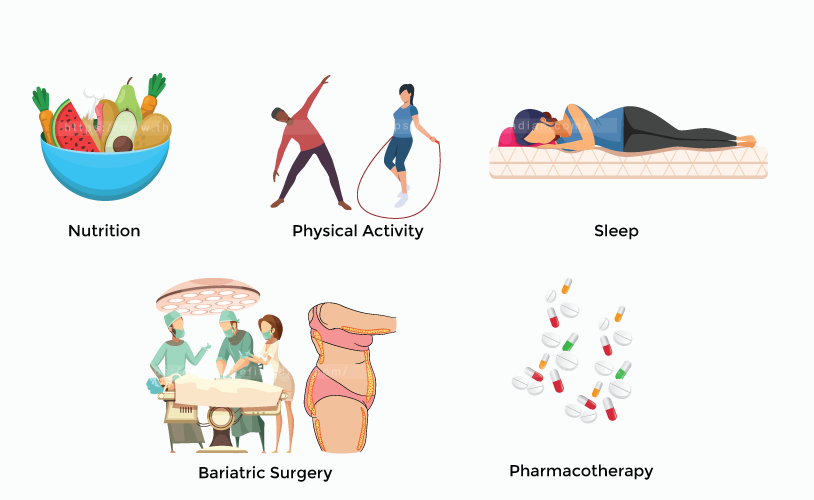 Nutrition
Nutrition
Getting rid of the excess calories and maintaining a healthy weight by opting for healthier and nutritional habits is the best option to overcome obesity. Physicians recommend that losing weight slowly and steadily, over a period of time, is better and safer. The main key to losing weight is reducing the intake of excess calories. It’s essential to review typical eating and drinking habits to see how many calories a person normally consumes and where he/she can cut back. To achieve and maintain body weight, metabolic control has proved to be a landmark in obesity management. Dietary advice should encourage healthy and nutritious eating to overcome obesity.
Physical Activity, Sedentary Behaviors, and Sleep
Personal behaviors beyond diet such as physical activity, sedentary, sleep and stress have also been independently associated with weight gain. Combined with diet, these elements have synergistic and likely cumulative effects on an individual’s ability to maintain or obtain a healthy body weight over the life course. Obesity is mostly related to a sedentary lifestyle.
Bariatric Surgery
Bariatric surgery or better referred to as metabolic surgery is any surgery performed on the stomach and/or intestines with the intent of resolution of metabolic syndrome for treating obesity. Surgery is reserved for cases of extreme obesity (BMI of >40 kg/m2) or for more moderate obesity (BMI of > 35 kg/m2) when obesity-related comorbidity conditions are present. Metabolic/bariatric surgery is the most effective and long-lasting treatment for severe obesity, resulting in significant weight loss and leading to the improvement, prevention or resolution of many related diseases. Studies show bariatric surgery may reduce a patient’s risk of premature death by 30-50%.
Pharmacotherapy
Anti-obesity drug therapy is indicated for those individuals who cannot achieve weight loss despite an adequate trial of lifestyle modification. Pharmacotherapy is mostly prescribed in conjunction with lifestyle modifications, and not as monotherapy for obesity. According to current Food and Drug Administration (FDA) guidance, pharmacotherapy is approved for patients with a BMI ≥ 30 kg/m2 or ≥27 kg/m2 when complicated by obesity comorbidities. Few agents are currently approved for the treatment of obesity. They are appetite suppressants or anorexiants and gastrointestinal fat blockers.
Preventive Measures for Obesity
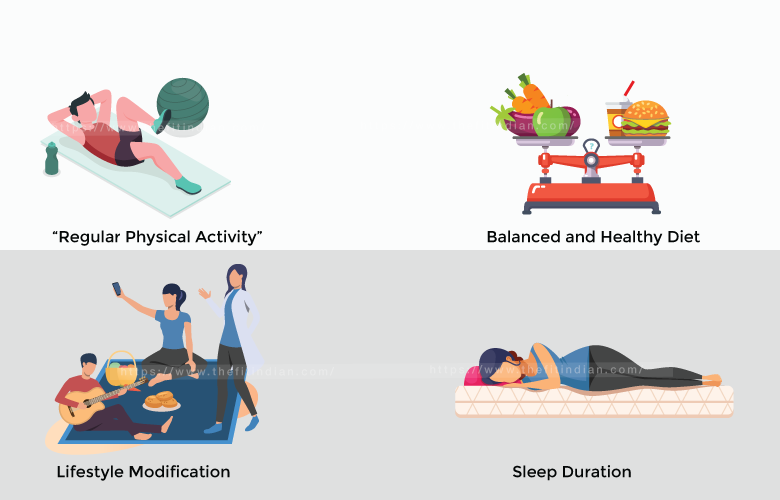 Regular Physical Exercise
Regular Physical Exercise
The practice of physical exercise plays a prominent role in the regulation of energy expenditure. Some levels of physical activity are better than none. Individuals that participate in any level of activity gain health benefits. Maintaining a healthy body weight or working to reduce your weight if you are overweight, can help to reduce your cholesterol levels, your blood pressure, as well as your blood sugar. Any form of physical activity is capable of producing positive adaptations to obesity and acts as an aid in its prevention and treatment.
Encourage a Balanced and Healthy Diet
Diets that are considered healthier lead to better long-term weight maintenance, or at least mitigate weight gain. In research it has been suggested that a rural Asian traditional diet (from any asian country) is most helpful. This diet includes the most healthful foods of a traditional Asian diet—it consists of a perfect balance of complex carbohydrates, fat, protein and fiber. Rural Asian diet has been proven in research to promote weight loss, helps in maintaining glucose control, and decreases total cholesterol and LDL (bad) cholesterol levels.
Sleep Duration
Obesity is a complex condition that can be influenced by a wide range of factors. One of these is sleep duration. Sleep deficiency is becoming widespread in both adults and adolescents and is accompanied by certain behaviors that can lead to obesity. Various studies have found that people with shorter sleep duration are more likely to be overweight or obese. 7-8 hours of sound sleep is a must for adults to maintain weight in a healthy way.
Lifestyle Modification
Creating a healthier lifestyle does not have to be difficult. Start with small changes and continue to focus on the big picture of living a healthier lifestyle. Everybody regardless of age, shape, size and ability needs to become more active every day. Being active in life is essential for wellbeing for physical and mental health. Avoid high intake of energy-dense foods, fast foods, large portion sizes along with rigid restraint in eating patterns. Limit consumption of alcohol and cease tobacco intake. In meaningful conjunction with diet, exercise, and behavioral strategies one can definitely have weight loss resulting in a healthy, happy life.
Maintaining Lost Weight
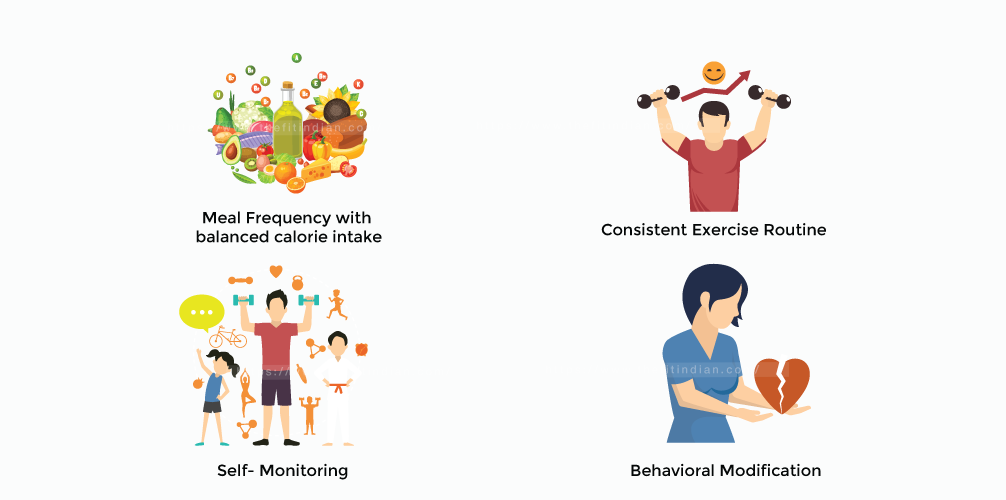 Meal Frequency with Balanced Calorie Intake
Meal Frequency with Balanced Calorie Intake
Human studies show that food consumption increases when there is more variety in a meal or diet and that greater dietary variety is associated with increased body weight and fat. Decrease the size of food portions to avoid snacking between meals. Do not skip breakfast and avoid eating at night time. Manage and reduce episodes of loss of control or binge eating. Ensure you have protein in every meal. It is important to limit the consumption of fast and processed food.
Behavioral Modification
Behavior modification is an important component for weight loss. Learning about the role of readiness in initiating or continuing positive behaviors, and recognizing barriers that may compromise healthy life have a positive effect on weight. Goal-setting, self-monitoring and continuous motivation and support are also important components, although no single theoretical framework for behavioral intervention has been shown to be superior. Successful weight maintenance lies in modifying the patterns of eating, consistency in physical activity and long-term modification of lifestyle.
Consistent Exercise Routine
Adherence to exercise and habitual physical activity are the greatest determinants of weight maintenance following weight loss. The effects of physical activity on fitness and health are dramatic, and there is evidence that physically active individuals who are obese have a lower risk for morbidity and mortality than sedentary individuals of normal weight. With these benefits, it’s always recommended to participate in a minimum of 30 minutes of modest-intensity physical activity almost every day. Thus, engaging in exercise and leading physically active lifestyles are especially important for individuals who are obese.
Self Monitoring Through Various Therapy
Physical therapists and other health care providers can play an important role in identifying individuals whose body weight places them at increased health risk. In addition, many people who begin treatment for obesity are unable to adhere to their treatment regimen for the duration needed to produce sufficient weight loss. A consistent support system involving physical therapists and other health care, nutritional professionals may be helpful in this regard.
FAD Diet
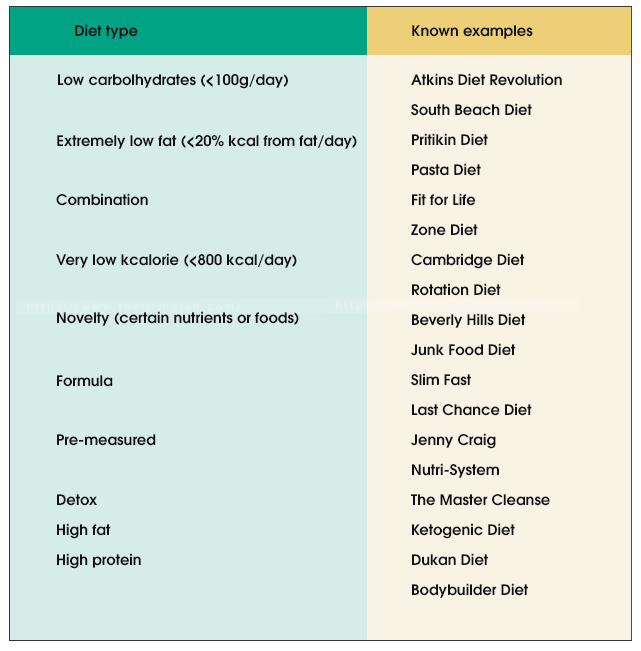 Are Fad Diets Really Beneficial?
Are Fad Diets Really Beneficial?
Fad diets are really low-calorie diets. Although fad diets may appeal as the simplest way to lose weight, recent studies have shown that such diets in the long term could result in various adverse side effects to health. All fad diets promise fast weight loss (more than 1 kg a week) without giving away fatty, rich-in-calories food and without the need to exercise regularly. Fad diets can lead to quick weight loss. Fad diets can also lead to quick weight regain and nutrient deficiencies.
Say No to Fad Diets
Fad diets have their misleading weight-loss claims like promises to solve weight problems without having to change the lifestyle in any way, rapid weight loss, magical fat-burning effects of some foods. They promote avoidance or severe limitation of a whole food group. Extreme weight loss followed by quick weight gain in fad diets is associated with many health risk factors such as heart disease, cancer, diabetes, and an increase in LDL cholesterol as well as reduced muscle and energy.
The Fit Indian Support (TFI)
 As rightly said, “Health is like money, we never have a real idea of its value until we lose it”; Health is one of the greatest wealths of life. When it comes to weight loss, which is largely a numbers game, let’s make a new resolution and have “lose weight” or “improve health” at the top of the to-do list.
As rightly said, “Health is like money, we never have a real idea of its value until we lose it”; Health is one of the greatest wealths of life. When it comes to weight loss, which is largely a numbers game, let’s make a new resolution and have “lose weight” or “improve health” at the top of the to-do list.
We are here to achieve meaningful weight loss for a person trying to lose weight permanently. TFI Diet Plan and diet aids along with workouts are of great value. Diet plans are personally developed by a nutritionist for the individual, and workouts are set as per the ailments. So come be a part of TFI. A simple way to lose weight in a healthy way!
Weekly Menu Plan
| Week 1 | Week 2 | Week 3 | Week 4 | |
|---|---|---|---|---|
| Early Morning(6 AM – 7 AM) | Have 2 glasses of Warm Water with 1/2 tsp of Soaked Methi Seeds
[AND] After 30 minutes, have 1 cup of Coffee or Tea with 1 tsp of Sugar (Optional) |
Have 2 glasses of Warm Water with 1/2 tsp of Flax Seeds
[AND] After 30 minutes, have 1 Cup of Coffee or Tea with 1 tsp of Sugar (optional) |
Have 2 glasses of Warm Water with 1/2 tsp of Jeera Seeds
[AND] After 30 minutes, have 1 Cup of Coffee or Tea with 1 tsp of Sugar (optional) |
Have 2 glasses of Warm Water With 1/2 Tsp of Soaked Methi Seeds
[AND] After 30 Minutes, have 1 Cup of Coffee or Tea with 1 tsp of Sugar( Optional) |
| Approximate Calories | 60kcal | 70kcal | 60kcal | 60kcal |
| Breakfast (8 AM – 10 AM) | Have 2 Ragi Idlis with 2 tbsp of Coriander Chutney and 2 Egg Whites. | Have 1 Cup of Peas Oats Upma with 1 tbsp of Tomato Chutney. | Have 1 Whole Wheat Bread Vegetable Sandwich ( 2 Slices of Brown Bread, Onion, Tomato, Cucumber) and 2 Boiled Egg Whites. | Have 2 Green Gram dosa with
2 tbsp of Carrot Ginger Chutney. |
| Approximate Calories | 220kcal | 200kcal | 230kcal | 200kcal |
| Midmorning (11 AM – 12 PM) | Have 1 Medium Sized Apple. | Have 1 Medium Sized Guava. | Have 1 Medium Sized Pear. | Have 1 Bowl of Papaya. |
| Approximate Calories | 80kcal | 65kcal | 65kcal | 120kcal |
| Lunch (12:30 PM to 2:00 PM) | Have 1 Cup of Green Bean Salad ( made With Green beans, Garlic, Salt, Pepper, Lime Juice), 1/2 Cup of Brown Rice with
1/2 Cup of Dal Palak Curry And 1 Glass of Buttermilk. |
Have 1 Cup of Corn Salad (made with Sweet Corn, Onion, Capsicum, Spices), 2 Wheat phulka with 1 Cup of Chicken Gravy And 1 Glass of Buttermilk. | Have 1 Cup of Chicken Salad ( made with Boiled Chicken, Carrot, Brocolli, Spring onion, Salt and Pepper), 1 Cup of any Millet Rice with
With 1 Cup of Mixed Vegetable Curry And 1 Glass of Buttermilk. |
Have 1 Cup of Vegetable Salad ( made with French Beans, Lettuce, Garlic, Salt, Pepper, Lime Juice) And
1/2 Cup of Dhaliya with 1 Cup of Dal Spring onion Curry And 1/2 Cup Of Low Fat Yogurt. |
| Approximate Calories | 350kcal | 400kcal | 420kcal | 350kcal |
| Snack (4:00 PM to 5:00 PM) | Have 1 cup of Green Tea
[AND] After 30 minutes, have 1 cup of Boiled White Channa. |
Have 1 cup of Green Tea
[AND] After 30 minutes, have 4 Almonds with 2 Dried Figs. |
Have 1 cup of Green Tea
[AND] After 30 minutes, have 1 Cup of Mixed Sprouts. |
Have 1 cup of Green Tea
[And] After 30 minutes, have 2 Small Khakra, 2 Walnuts. |
| Approximate Calories | 120kcal | 110kcal | 130kcal | 130kcal |
| Dinner(7:00 PM to 8:30 PM) | Have 1 Grilled Fish Fillet, 1 Jowar Phulka with 1 Cup of Ivy Gourd Curry. | Have 1 Cup of Chicken Soup, 1 Cup of Quinoa Upma with 1 Cup of Brinjal Curry. | Have 1 cup of Mixed Vegetable Soup, 2-3 Phulkas With 1 Cup of Capsicum Egg White Gravy. | Have 1 cup of Paneer Baby Corn Salad, 1 Methi Paratha with 1/2 Cup of Curd Raita. |
| Approximate Calories | 300kcal | 300kcal | 250kcal | 270kcal |
| Bedtime(9:00 PM to 10:00 PM) | Have 1 glass of Warm Water before going to bed. | Have 1 glass of Warm Water before going to bed. | Have 1 glass of Warm Water before going to bed. | Have 1 glass of Warm Water before going to bed. |
| Approximate Calories | 0kcal | 0kcal | 0kcal | 0kcal |
| Total Calories | 1200kcal | 1200kcal | 1200kcal | 1200kcal |
Workouts
We offer an exercise program with a meal plan that suits your schedule and your preferences. It is important to encourage young people to participate in physical activity that is appropriate to their age, which makes them happy, and offers a variety.
Aerobic: Regular walking or jogging 5 days a week 30-40 minutes is advised. Swimming is also a good option as a fun hobby and a full-body activity. Swimming on an average 20-30 minutes.
Armchair workouts: These exercises, which are performed while seated and are intended for people with physical limitations, increase stamina, muscle tone, flexibility, and coordination.
Strength training: This type of exercise builds muscle, which burns more calories than fat even when you are not exercising. Aim for two to three sessions of strength training weekly, on alternate days.
Stretching: Aim to do stretching exercises at least three times weekly, including before your other workouts. Stretching also promotes better circulation.
Supplement Therapy
Multivitamins
Multivitamins ensure adequate nutrition, and help overcome deficiencies. It has been observed that they boost the metabolic rate of the body.
Amla
Amla helps in keeping the digestive system on track and accelerates the metabolic rate of the body. A good metabolism ultimately aids in burning more calories effectively.
Garcinia Cambogia
The skin of Garcinia Cambogia contains high levels of hydroxycitric acid (HCA). Garcinia Cambogia may also increase metabolic activity, further promoting weight loss.
Green Tea
It is an antioxidant. Various studies have shown green tea extract as fat burner, boosting the effects of some fat-burning hormones.
Green Coffee Bean
Caffeine in green coffee helps regulate hormones that boost thermogenesis, a process that burns calories to produce heat during digestion.
Apple Cider Vinegar
Apple Cider Vinegar increases the feeling of satiety (the feeling of being full) when consumed before a meal. This results in consuming fewer calories throughout the day. All these effects combined help with weight loss.
Conclusions
Obesity is a health condition that is becoming a worldwide epidemic. Since it contributes to numerous chronic diseases and leads to early mortality, it needs special focus and the best care. Root causes of obesity may be dietary patterns, genetic factors, age, gender, social- behaviour, decrease in physical activity, and other environmental factors.
Other contributors to obesity are leptin deficiency, overeating, lack of sleep, a more simple and less complex carbohydrate diet, and sometimes it may be drug induced.
The correlation of excess body weight gain with various health complications is very strong; obesity is closely associated with cardiovascular disease, diabetes mellitus, cancer, osteoartritis, gallbladder disease, gout and may even lead to mortality.
With TFI support one can lose weight slowly and steadily over a period of time in a healthy and sustainable manner, which is recommended. Getting rid of excess calories and maintaining a healthy weight could be achieved by opting for a nutritional and balanced calorie intake with our nutrition support and customized diets. With a consistent exercise routine and healthy lifestyle implemented through self monitoring one can easily start shedding the extra pounds.
As it is mostly observed that weight loss is a numbers game. Lets achieve meaningful, sustainable and healthy weight loss.

Compiled by
Dr Vrushali Pulate (PhD in Bio process Technology)
Technical Content Director and Product Head
Pyrite Fitness Pvt. Ltd.
Her research interests are biosurfactants, pharma biotech, food sciences, analytical chemistry with five international publications in peer-reviewed journals. Awarded research fellowship DBT- India (2007-2009) and UGC-SAP- Delhi India (2009-2014).
Frequently Asked Questions
Obesity is now considered an epidemic worldwide. In one of the largest studies ever to examine obesity rates across the globe, researchers found that more than 60% of men and 50% of women were either overweight or obese.
The most common approach to measuring obesity is the Body Mass Index (BMI). Though various other screening methods such as waist circumference, Waist to Hip Ratio, and Body shapes and patterns and some systemic/blood examination are also recommended.
Encouraging a balanced and healthy diet, regular physical exercise, having good sleep, and good lifestyle habits. Start with small changes and the outcomes are worthy and lifelong.
In various studies, it has been found that for persons with severe obesity (BMI ≥40), there are high chances of reduced life expectancy, so one needs to seek medical and nutritional assistance.
Though it is not recommended, one can have fast food once a week to prevent excess food cravings. Try to have healthier options now available at most fast-food restaurants.
If one adheres to nutritional habits with a good diet and habitual physical activity along with self-monitoring, one can be back to shape in 1-2 years depending upon the BMI.
The practice of physical exercise plays a prominent role in the regulation of energy expenditure. Get more exercise as it is the best way to control cholesterol levels. Some levels of physical level are better than none, and adults that participate in any level of activity gain health benefits.
Eating habits and dietary modifications make vital measures to overcome the problem of obesity. The perfect balance of complex carbohydrates, fat, protein and fiber has been proven to promote weight loss.
Anti-obesity drug therapy is indicated for those individuals who cannot achieve weight loss despite an adequate trial of lifestyle modification. One should go for medication through physician recommendation only.
This surgery is recommended for extreme obesity (BMI of >40 kg/m2) or for more moderate obesity (BMI of > 35 kg/m2) when obesity-related comorbidities conditions are present. Bariatric surgery or better referred to as metabolic surgery is any surgery performed on the stomach and/or intestines.
- Obesity: Overview of Prevalence; Etiology, and Treatment Physical Therapy; Vol- 83:2003
- Obesity: A Review of Pathogenesis and Management Strategies in Adult; Delta Med Col J. Jan; Vol-5: 2017
- The Epidemiology of Obesity: A Big Picture; Pharmacoeconomics; 33; 2015
- Diet and Disease Nutrition for Heart Disease, Diabetes, and Metabolic Stress. By Katie Ferraro, December 2015.
- Prevention of Overweight and Obesity: How Effective is the Current Public Health Approach Int. J. Environ. Res. Public Health 2010
- Fad diets, miracle diets, diet cult… but no results; JONNPR Vol-2: 2017
- Fad Diets: Lifestyle Promises and Health Challenges; Journal of Food Research; Vol. 5, 2016
- Medications that cause weight gain and alternatives in Canada: A narrative Review; Diabetes, Metabolic Syndrome and Obesity: Targets and Therapy; Vol-11; 2018
- Genetics of Obesity; Ind J Clin Biochem Vol- 31: 2016
- Health Risks of Overweight and Obesity – An Overview; Pakistan Journal of Nutrition; Vol-2: 2003
- Diet, nutrition and the prevention of excess weight gain and obesity; Public Health Nutrition. Vol- 7: 2004
- Natural anti-obesity agents and their therapeutic role in the management of obesity: A future trend perspective: Biomedicine & Pharmacotherapy; Vol-110:2019